The Pros and Cons of Insulin Pump Therapy

Editor’s Note: In his book, Think Like A Pancreas: A Practical Guide to Managing Diabetes With Insulin, certified diabetes educator Gary Scheiner devotes a chapter on the basics of insulin pump therapy. While studies show that pump therapy, when done right, leads to better blood sugar control, it’s not for everyone. Scheiner gives a concise pro/con list of using an insulin pump. With his permission, we are sharing that list:
The benefits of pump therapy include:
1. Better blood sugars. First and foremost. Pump users tend to have lower A1C scores and less glucose variability (fewer “high to low” and “low to high” swings) than those on injections.
2. Fewer lows. By using only rapid-acting insulin, there is no long-acting insulin peaking or working too hard at inappropriate times. This makes pump therapy a good choice for those who have frequent lows, a history of severe lows, or a hard time detecting low blood sugars.
3. A more flexible lifestyle. Raise your hand if you can eat, sleep and exercise at the same times every day. The pump lets you choose your own schedule.
4. Dose calculations. Modern pumps come equipped with a bolus calculator that helps the user determine mealtime doses based on carb intake, blood glucose levels, and the amount of insulin still active from previous boluses. Imagine that… no math!
5. Precise dosing. Pumps deliver insulin to the nearest .1, .05 or .025 units; ideal for those who are sensitive to very small doses, such as children and lean/active adults.
6. Convenience. There is no need to draw up syringes every time you need insulin; just reach to your pump and press a few buttons.
7. No Shots. Multiple daily insulin injections can be uncomfortable and cause skin problems; pumps only require a needle stick once every 2-3 days to change the infusion set.
8. Easy adjustments for real life. Temporary basal insulin changes help maintain stable blood sugar during periods of growth, illness, seasonal sports, dining out, and menstruation. The ability to deliver boluses all at once or over a prolonged period of time can be instrumental in achieving optimal after-meal glucose control.
9. Weight Control. Eat what/when you choose; snacks are not required when you use a pump.
10. Data analysis. Insulin pumps store a plethora of historical information that can be displayed on-screen or transmitted to various computer programs for analysis and fine-tuning.
Potential drawbacks to pump therapy include:
1. Cost. Although most insurance plans cover insulin pumps and supplies, there are often co-pays and deductibles that must be met.
2. A learning curve. Don’t expect good control right away. It usually takes a few months to get the basal and bolus doses regulated and to adjust to using the pump correctly.
3. Inconvenience. Wearing the pump around the clock, even during sleep, can become awkward once in awhile. My infusion set tubing gets caught on a doorknob at least once a month!
4. Technical Difficulties. As mechanical devices, pumps are prone to occasional infusion set clogs, electronic failures, computer glitches and damage due to typical wear and tear.
5. Skin Problems. Skin can become irritated from infusion set adhesive, and infections can occur if infusion sets are worn too long or inserted improperly. Insulin absorption can be hindered if infusion sets are not changed regularly and sites are not rotated properly.
6. Ketosis. The absence of long-acting insulin with pump use can present a problem if insulin delivery is interrupted for more than a few hours. Blood sugar can rise very quickly, and ketones may appear in the bloodstream and urine if the problem is not corrected.
7. Infusion Set Changes. Every couple of days, the pump user must change his/her own infusion set. This three-minute to 10-minute procedure involves numerous steps and can be momentarily uncomfortable or traumatic for the novice pump user.
(excerpted from Think Like A Pancreas: A Practical Guide to Managing Diabetes With Insulin by Gary Scheiner MS, CDE, DaCapo Press, 2011)
Gary Scheiner and his team of clinicians at Integrated Diabetes Services are available for individual consultations via phone and the internet. Visit www.integrateddiabetes.com call 1-610-642-6055 for more information.
If you would like to purchase a signed copy of Think Like a Pancreas, call Integrated Diabetes Services directly at (877) 735-3648; (outside the US 1-610-642-6055), or order it through the IDS store here.
Thanks for reading this Insulin Nation article. Want more Type 1 news? Subscribe here.
Have Type 2 diabetes or know someone who does? Try Type 2 Nation, our sister publication.